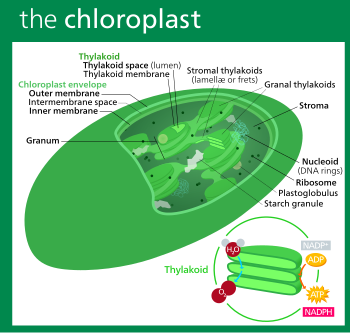

A chloroplast (/ˈklɔːrəˌplæst, -plɑːst/)[1][2] is a type of organelle known as a plastid that conducts photosynthesis mostly in plant and algal cells. Chloroplasts have a high concentration of chlorophyll pigments which capture the energy from sunlight and convert it to chemical energy and release oxygen. The chemical energy created is then used to make sugar and other organic molecules from carbon dioxide in a process called the Calvin cycle. Chloroplasts carry out a number of other functions, including fatty acid synthesis, amino acid synthesis, and the immune response in plants. The number of chloroplasts per cell varies from one, in some unicellular algae, up to 100 in plants like Arabidopsis and wheat.
Chloroplasts are highly dynamic—they circulate and are moved around within cells. Their behavior is strongly influenced by environmental factors like light color and intensity. Chloroplasts cannot be made anew by the plant cell and must be inherited by each daughter cell during cell division, which is thought to be inherited from their ancestor—a photosynthetic cyanobacterium that was engulfed by an early eukaryotic cell.[3]
Chloroplasts evolved from an ancient cyanobacterium that was engulfed by an early eukaryotic cell. Because of their endosymbiotic origins, chloroplasts, like mitochondria, contain their own DNA separate from the cell nucleus. With one exception (the amoeboid Paulinella chromatophora), all chloroplasts can be traced back to a single endosymbiotic event. Despite this, chloroplasts can be found in extremely diverse organisms that are not directly related to each other—a consequence of many secondary and even tertiary endosymbiotic events.
- ^ Jones D (2003) [1917]. Roach P, Hartmann J, Setter J (eds.). English Pronouncing Dictionary. Cambridge: Cambridge University Press. ISBN 3-12-539683-2.
- ^ "Chloroplast". Merriam-Webster.com Dictionary. Merriam-Webster.
- ^ Basic Biology (18 March 2016). "Bacteria".